Assyrian/Chaldean/Syriac vs Immigrants from Peru Community Comparison
COMPARE
Assyrian/Chaldean/Syriac
Immigrants from Peru
Social Comparison
Social Comparison
Assyrians/Chaldeans/Syriacs
Immigrants from Peru
7,301
SOCIAL INDEX
70.5/ 100
SOCIAL RATING
124th/ 347
SOCIAL RANK
5,294
SOCIAL INDEX
50.4/ 100
SOCIAL RATING
181st/ 347
SOCIAL RANK
Immigrants from Peru Integration in Assyrian/Chaldean/Syriac Communities
The statistical analysis conducted on geographies consisting of 96,326,773 people shows a slight positive correlation between the proportion of Immigrants from Peru within Assyrian/Chaldean/Syriac communities in the United States with a correlation coefficient (R) of 0.080. On average, for every 1% (one percent) increase in Assyrians/Chaldeans/Syriacs within a typical geography, there is an increase of 0.008% in Immigrants from Peru. To illustrate, in a geography comprising of 100,000 individuals, a rise of 1,000 Assyrians/Chaldeans/Syriacs corresponds to an increase of 8.5 Immigrants from Peru.
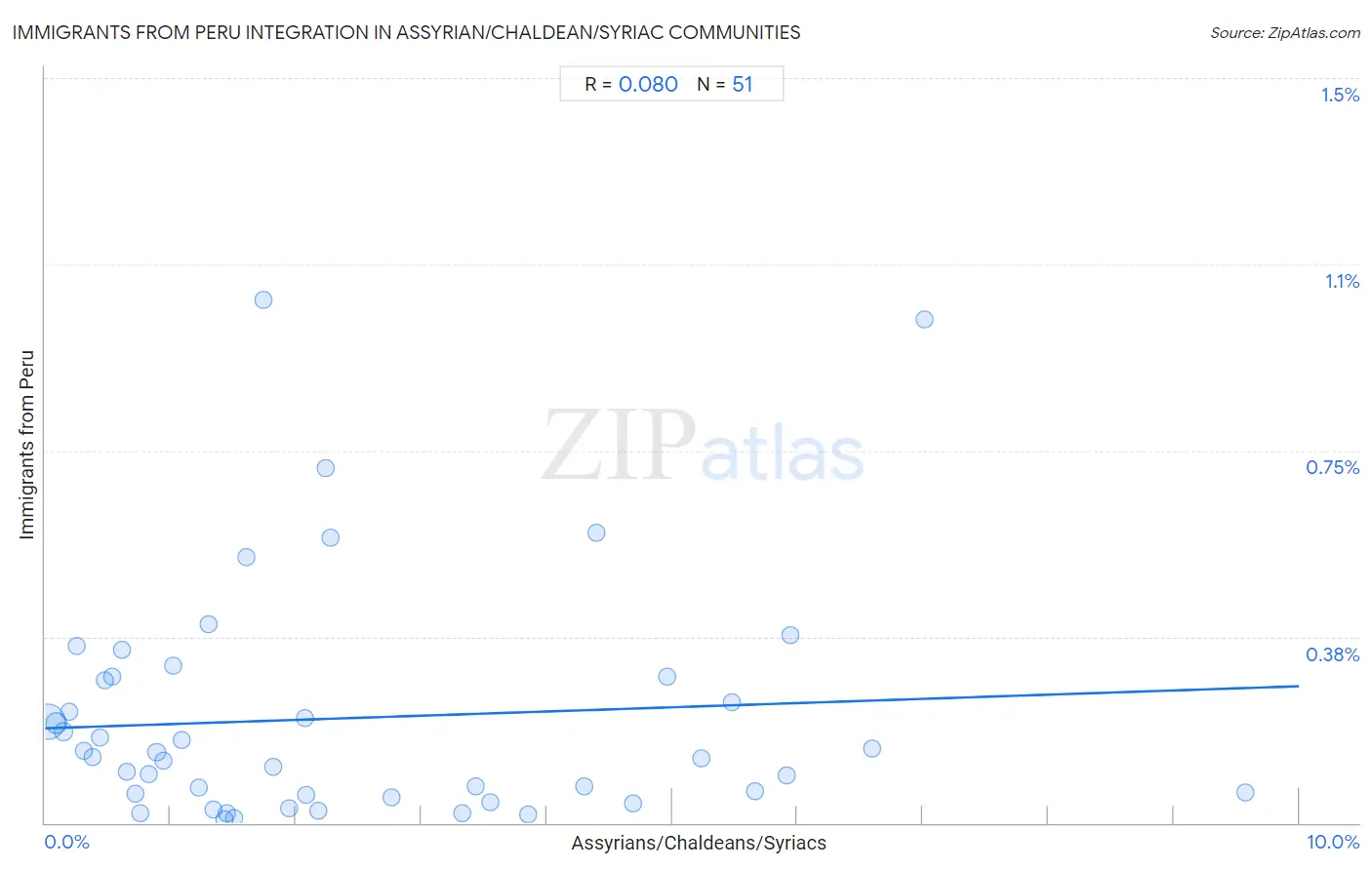
Assyrian/Chaldean/Syriac vs Immigrants from Peru Income
When considering income, the most significant differences between Assyrian/Chaldean/Syriac and Immigrants from Peru communities in the United States are seen in wage/income gap (31.0% compared to 25.1%, a difference of 23.4%), householder income under 25 years ($65,329 compared to $56,384, a difference of 15.9%), and median male earnings ($58,437 compared to $54,695, a difference of 6.8%). Conversely, both communities are more comparable in terms of median female earnings ($39,159 compared to $39,871, a difference of 1.8%), median earnings ($48,304 compared to $47,025, a difference of 2.7%), and per capita income ($45,195 compared to $43,852, a difference of 3.1%).

| Income Metric | Assyrian/Chaldean/Syriac | Immigrants from Peru |
| Per Capita Income | Excellent $45,195 | Average $43,852 |
| Median Family Income | Exceptional $109,622 | Good $103,534 |
| Median Household Income | Exceptional $91,991 | Exceptional $89,010 |
| Median Earnings | Exceptional $48,304 | Good $47,025 |
| Median Male Earnings | Exceptional $58,437 | Average $54,695 |
| Median Female Earnings | Fair $39,159 | Average $39,871 |
| Householder Age | Under 25 years | Exceptional $65,329 | Exceptional $56,384 |
| Householder Age | 25 - 44 years | Exceptional $101,936 | Excellent $97,329 |
| Householder Age | 45 - 64 years | Exceptional $110,201 | Excellent $103,173 |
| Householder Age | Over 65 years | Exceptional $64,108 | Good $61,988 |
| Wage/Income Gap | Tragic 31.0% | Excellent 25.1% |
Assyrian/Chaldean/Syriac vs Immigrants from Peru Poverty
When considering poverty, the most significant differences between Assyrian/Chaldean/Syriac and Immigrants from Peru communities in the United States are seen in single father poverty (11.7% compared to 15.3%, a difference of 30.8%), seniors poverty over the age of 75 (10.7% compared to 13.7%, a difference of 27.6%), and seniors poverty over the age of 65 (9.6% compared to 12.0%, a difference of 25.1%). Conversely, both communities are more comparable in terms of married-couple family poverty (4.9% compared to 5.4%, a difference of 10.6%), receiving food stamps (10.6% compared to 12.0%, a difference of 13.7%), and female poverty among 25-34 year olds (11.2% compared to 12.7%, a difference of 13.9%).
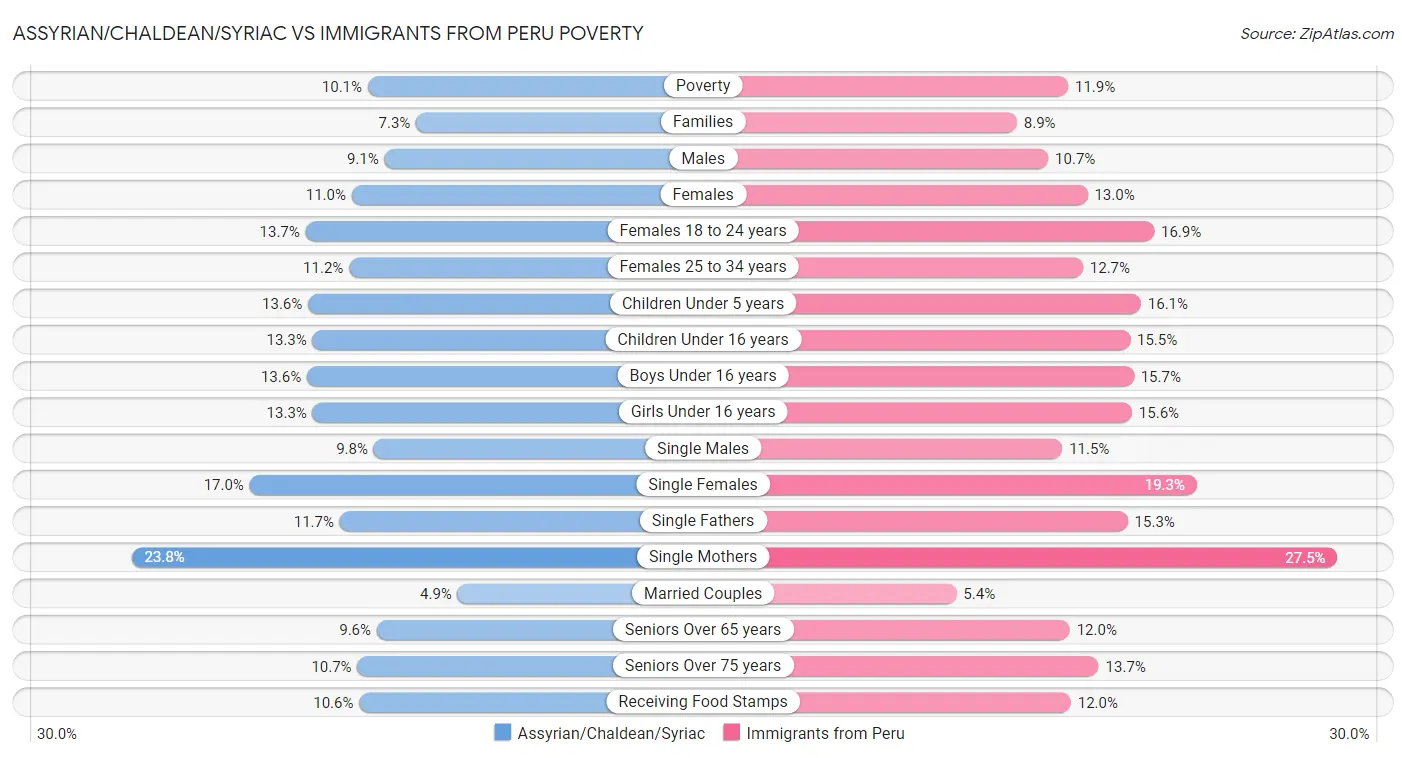
| Poverty Metric | Assyrian/Chaldean/Syriac | Immigrants from Peru |
| Poverty | Exceptional 10.1% | Excellent 11.9% |
| Families | Exceptional 7.3% | Average 8.9% |
| Males | Exceptional 9.1% | Excellent 10.7% |
| Females | Exceptional 11.0% | Good 13.0% |
| Females 18 to 24 years | Exceptional 13.7% | Exceptional 16.9% |
| Females 25 to 34 years | Exceptional 11.2% | Exceptional 12.7% |
| Children Under 5 years | Exceptional 13.6% | Exceptional 16.1% |
| Children Under 16 years | Exceptional 13.3% | Excellent 15.5% |
| Boys Under 16 years | Exceptional 13.6% | Excellent 15.7% |
| Girls Under 16 years | Exceptional 13.3% | Excellent 15.6% |
| Single Males | Exceptional 9.8% | Exceptional 11.5% |
| Single Females | Exceptional 17.0% | Exceptional 19.3% |
| Single Fathers | Exceptional 11.7% | Exceptional 15.3% |
| Single Mothers | Exceptional 23.8% | Exceptional 27.5% |
| Married Couples | Excellent 4.9% | Fair 5.4% |
| Seniors Over 65 years | Exceptional 9.6% | Tragic 12.0% |
| Seniors Over 75 years | Exceptional 10.7% | Tragic 13.7% |
| Receiving Food Stamps | Exceptional 10.6% | Fair 12.0% |
Assyrian/Chaldean/Syriac vs Immigrants from Peru Unemployment
When considering unemployment, the most significant differences between Assyrian/Chaldean/Syriac and Immigrants from Peru communities in the United States are seen in unemployment among women with children ages 6 to 17 years (7.2% compared to 9.2%, a difference of 27.3%), unemployment among seniors over 75 years (11.1% compared to 8.9%, a difference of 24.5%), and unemployment among women with children under 6 years (6.5% compared to 7.5%, a difference of 16.3%). Conversely, both communities are more comparable in terms of unemployment among youth under 25 years (11.9% compared to 11.8%, a difference of 0.51%), unemployment among ages 16 to 19 years (17.9% compared to 17.7%, a difference of 0.96%), and unemployment (5.3% compared to 5.4%, a difference of 1.2%).
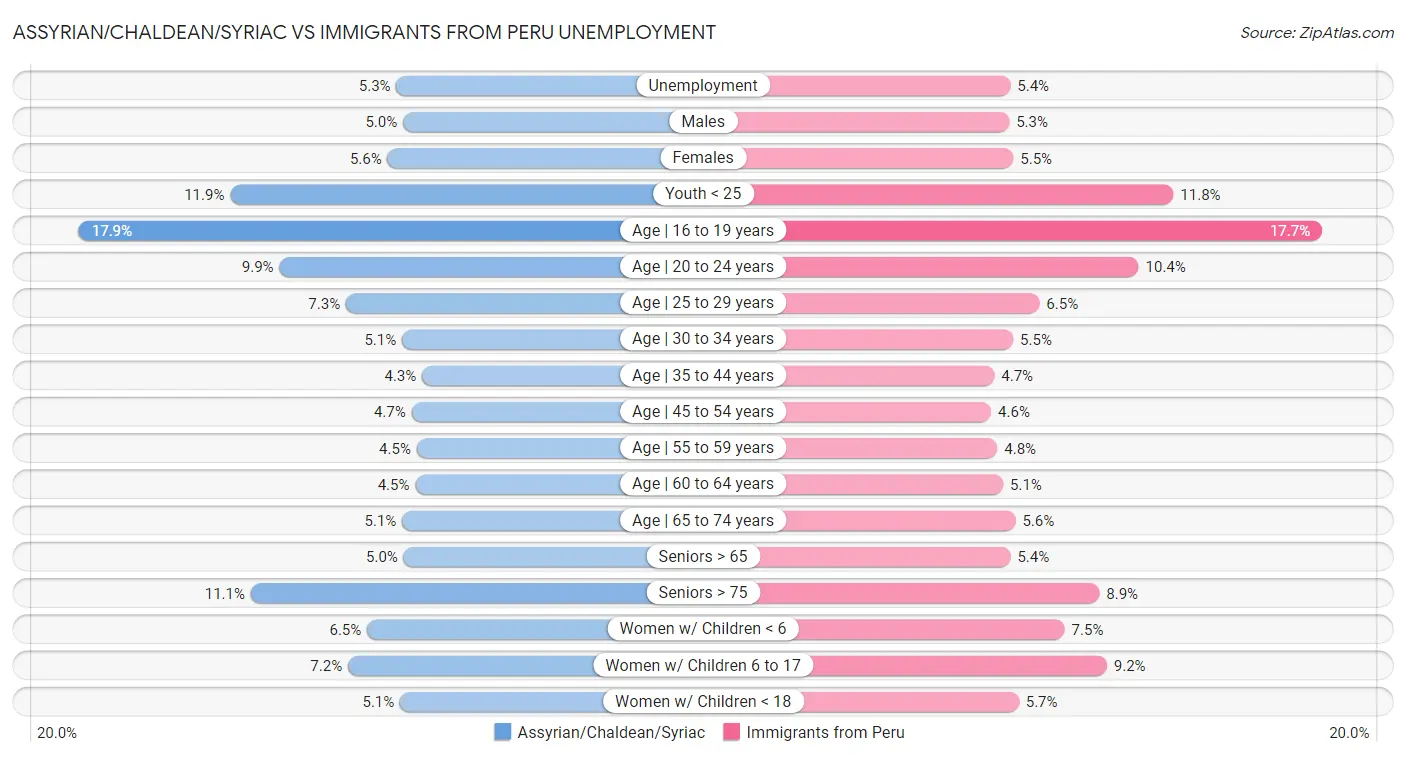
| Unemployment Metric | Assyrian/Chaldean/Syriac | Immigrants from Peru |
| Unemployment | Fair 5.3% | Fair 5.4% |
| Males | Exceptional 5.0% | Average 5.3% |
| Females | Tragic 5.6% | Tragic 5.5% |
| Youth < 25 | Tragic 11.9% | Poor 11.8% |
| Age | 16 to 19 years | Fair 17.9% | Fair 17.7% |
| Age | 20 to 24 years | Exceptional 9.9% | Fair 10.4% |
| Age | 25 to 29 years | Tragic 7.3% | Good 6.5% |
| Age | 30 to 34 years | Exceptional 5.1% | Average 5.5% |
| Age | 35 to 44 years | Exceptional 4.3% | Fair 4.7% |
| Age | 45 to 54 years | Tragic 4.7% | Poor 4.6% |
| Age | 55 to 59 years | Exceptional 4.5% | Fair 4.8% |
| Age | 60 to 64 years | Exceptional 4.5% | Tragic 5.1% |
| Age | 65 to 74 years | Exceptional 5.1% | Tragic 5.6% |
| Seniors > 65 | Exceptional 5.0% | Tragic 5.4% |
| Seniors > 75 | Tragic 11.1% | Fair 8.9% |
| Women w/ Children < 6 | Exceptional 6.5% | Good 7.5% |
| Women w/ Children 6 to 17 | Exceptional 7.2% | Poor 9.2% |
| Women w/ Children < 18 | Exceptional 5.1% | Tragic 5.7% |
Assyrian/Chaldean/Syriac vs Immigrants from Peru Labor Participation
When considering labor participation, the most significant differences between Assyrian/Chaldean/Syriac and Immigrants from Peru communities in the United States are seen in in labor force | age 16-19 (38.3% compared to 34.2%, a difference of 12.2%), in labor force | age > 16 (64.0% compared to 66.3%, a difference of 3.5%), and in labor force | age 20-24 (75.9% compared to 74.5%, a difference of 1.9%). Conversely, both communities are more comparable in terms of in labor force | age 25-29 (84.7% compared to 84.7%, a difference of 0.060%), in labor force | age 45-54 (83.2% compared to 83.5%, a difference of 0.40%), and in labor force | age 35-44 (84.0% compared to 84.9%, a difference of 1.1%).

| Labor Participation Metric | Assyrian/Chaldean/Syriac | Immigrants from Peru |
| In Labor Force | Age > 16 | Tragic 64.0% | Exceptional 66.3% |
| In Labor Force | Age 20-64 | Fair 79.4% | Exceptional 80.3% |
| In Labor Force | Age 16-19 | Exceptional 38.3% | Tragic 34.2% |
| In Labor Force | Age 20-24 | Exceptional 75.9% | Poor 74.5% |
| In Labor Force | Age 25-29 | Average 84.7% | Average 84.7% |
| In Labor Force | Age 30-34 | Tragic 83.2% | Average 84.7% |
| In Labor Force | Age 35-44 | Tragic 84.0% | Exceptional 84.9% |
| In Labor Force | Age 45-54 | Exceptional 83.2% | Exceptional 83.5% |
Assyrian/Chaldean/Syriac vs Immigrants from Peru Family Structure
When considering family structure, the most significant differences between Assyrian/Chaldean/Syriac and Immigrants from Peru communities in the United States are seen in births to unmarried women (22.0% compared to 31.8%, a difference of 44.8%), single mother households (4.8% compared to 6.7%, a difference of 38.4%), and single father households (2.0% compared to 2.4%, a difference of 22.5%). Conversely, both communities are more comparable in terms of family households (68.2% compared to 67.2%, a difference of 1.4%), average family size (3.24 compared to 3.31, a difference of 2.1%), and family households with children (28.1% compared to 28.9%, a difference of 2.9%).

| Family Structure Metric | Assyrian/Chaldean/Syriac | Immigrants from Peru |
| Family Households | Exceptional 68.2% | Exceptional 67.2% |
| Family Households with Children | Exceptional 28.1% | Exceptional 28.9% |
| Married-couple Households | Exceptional 51.8% | Excellent 47.3% |
| Average Family Size | Good 3.24 | Exceptional 3.31 |
| Single Father Households | Exceptional 2.0% | Poor 2.4% |
| Single Mother Households | Exceptional 4.8% | Poor 6.7% |
| Currently Married | Exceptional 50.8% | Fair 46.4% |
| Divorced or Separated | Exceptional 10.6% | Average 12.0% |
| Births to Unmarried Women | Exceptional 22.0% | Average 31.8% |
Assyrian/Chaldean/Syriac vs Immigrants from Peru Vehicle Availability
When considering vehicle availability, the most significant differences between Assyrian/Chaldean/Syriac and Immigrants from Peru communities in the United States are seen in no vehicles in household (7.0% compared to 11.5%, a difference of 64.6%), 3 or more vehicles in household (21.7% compared to 19.4%, a difference of 12.2%), and 4 or more vehicles in household (7.2% compared to 6.4%, a difference of 11.9%). Conversely, both communities are more comparable in terms of 1 or more vehicles in household (93.0% compared to 88.6%, a difference of 5.0%), 2 or more vehicles in household (60.5% compared to 54.4%, a difference of 11.4%), and 4 or more vehicles in household (7.2% compared to 6.4%, a difference of 11.9%).

| Vehicle Availability Metric | Assyrian/Chaldean/Syriac | Immigrants from Peru |
| No Vehicles Available | Exceptional 7.0% | Tragic 11.5% |
| 1+ Vehicles Available | Exceptional 93.0% | Tragic 88.6% |
| 2+ Vehicles Available | Exceptional 60.5% | Poor 54.4% |
| 3+ Vehicles Available | Exceptional 21.7% | Average 19.4% |
| 4+ Vehicles Available | Exceptional 7.2% | Average 6.4% |
Assyrian/Chaldean/Syriac vs Immigrants from Peru Education Level
When considering education level, the most significant differences between Assyrian/Chaldean/Syriac and Immigrants from Peru communities in the United States are seen in college, under 1 year (67.7% compared to 63.1%, a difference of 7.2%), college, 1 year or more (61.5% compared to 57.7%, a difference of 6.5%), and bachelor's degree (39.8% compared to 37.5%, a difference of 6.1%). Conversely, both communities are more comparable in terms of nursery school (97.6% compared to 97.5%, a difference of 0.050%), kindergarten (97.5% compared to 97.5%, a difference of 0.060%), and 1st grade (97.5% compared to 97.4%, a difference of 0.070%).
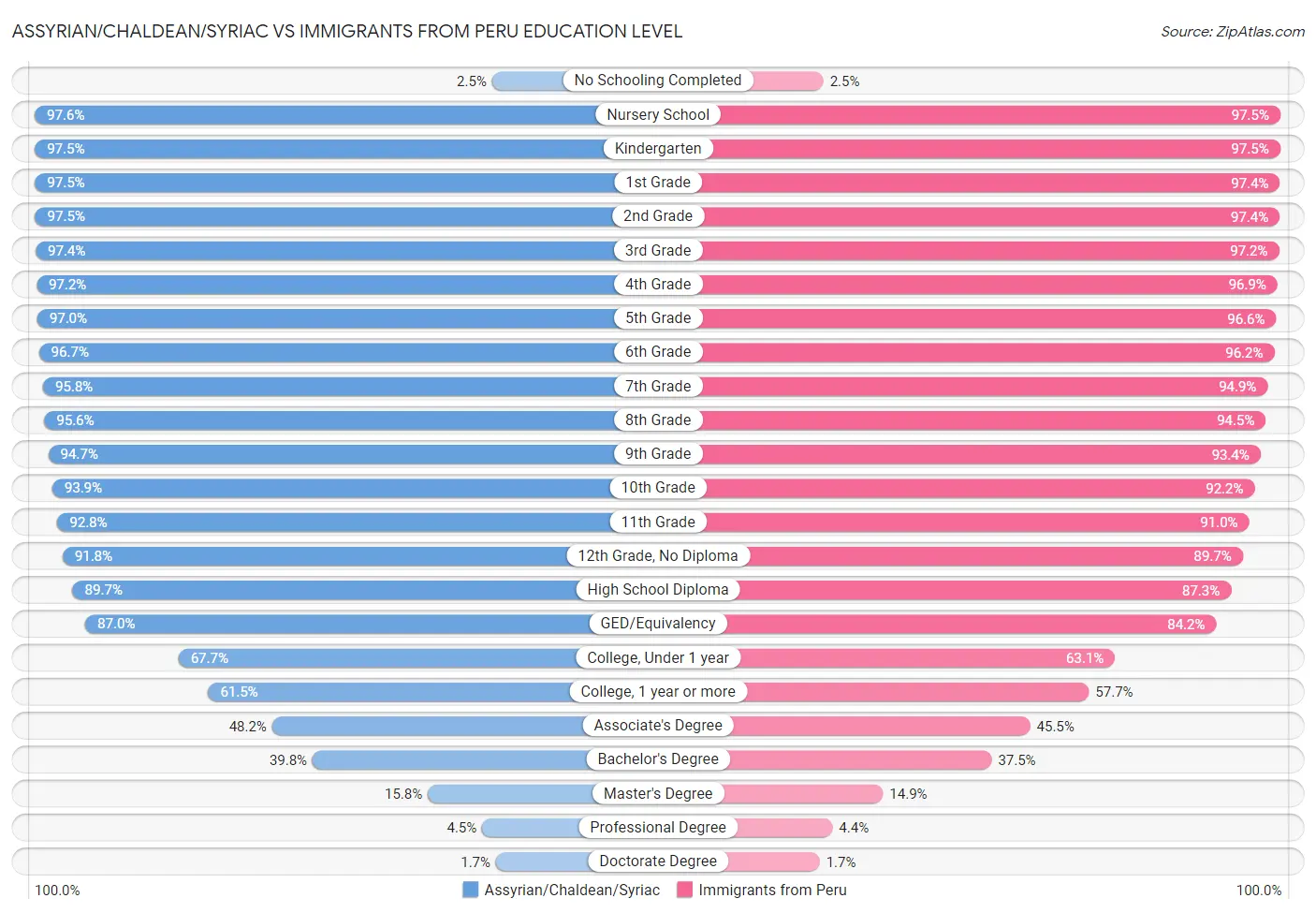
| Education Level Metric | Assyrian/Chaldean/Syriac | Immigrants from Peru |
| No Schooling Completed | Tragic 2.5% | Tragic 2.5% |
| Nursery School | Tragic 97.6% | Tragic 97.5% |
| Kindergarten | Tragic 97.5% | Tragic 97.5% |
| 1st Grade | Tragic 97.5% | Tragic 97.4% |
| 2nd Grade | Tragic 97.5% | Tragic 97.4% |
| 3rd Grade | Tragic 97.4% | Tragic 97.2% |
| 4th Grade | Tragic 97.2% | Tragic 96.9% |
| 5th Grade | Tragic 97.0% | Tragic 96.6% |
| 6th Grade | Tragic 96.7% | Tragic 96.2% |
| 7th Grade | Fair 95.8% | Tragic 94.9% |
| 8th Grade | Fair 95.6% | Tragic 94.5% |
| 9th Grade | Fair 94.7% | Tragic 93.4% |
| 10th Grade | Good 93.9% | Tragic 92.2% |
| 11th Grade | Excellent 92.8% | Tragic 91.0% |
| 12th Grade, No Diploma | Excellent 91.8% | Tragic 89.7% |
| High School Diploma | Excellent 89.7% | Tragic 87.3% |
| GED/Equivalency | Exceptional 87.0% | Tragic 84.2% |
| College, Under 1 year | Exceptional 67.7% | Tragic 63.1% |
| College, 1 year or more | Exceptional 61.5% | Poor 57.7% |
| Associate's Degree | Excellent 48.2% | Fair 45.5% |
| Bachelor's Degree | Excellent 39.8% | Average 37.5% |
| Master's Degree | Excellent 15.8% | Average 14.9% |
| Professional Degree | Good 4.5% | Average 4.4% |
| Doctorate Degree | Tragic 1.7% | Poor 1.7% |
Assyrian/Chaldean/Syriac vs Immigrants from Peru Disability
When considering disability, the most significant differences between Assyrian/Chaldean/Syriac and Immigrants from Peru communities in the United States are seen in hearing disability (3.3% compared to 2.7%, a difference of 23.3%), self-care disability (2.8% compared to 2.4%, a difference of 17.7%), and disability age under 5 (1.1% compared to 1.2%, a difference of 14.0%). Conversely, both communities are more comparable in terms of cognitive disability (16.2% compared to 16.6%, a difference of 2.4%), vision disability (2.0% compared to 2.1%, a difference of 3.0%), and disability age 18 to 34 (6.1% compared to 5.9%, a difference of 3.8%).
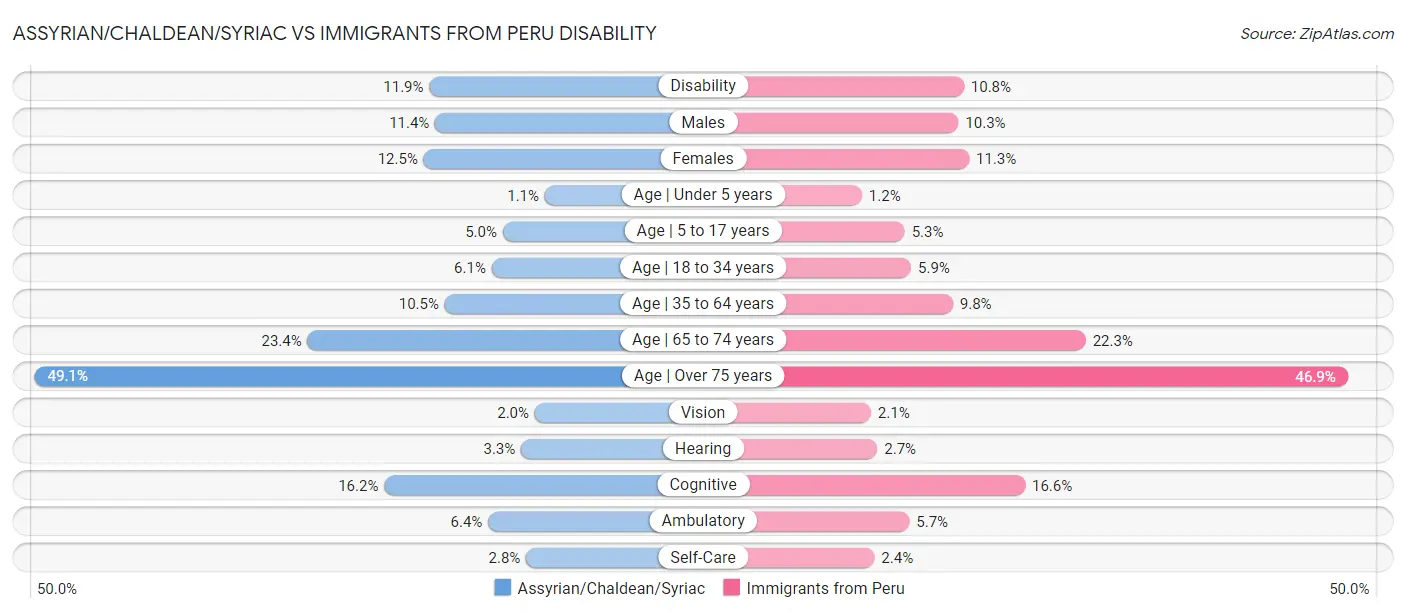
| Disability Metric | Assyrian/Chaldean/Syriac | Immigrants from Peru |
| Disability | Poor 11.9% | Exceptional 10.8% |
| Males | Fair 11.4% | Exceptional 10.3% |
| Females | Tragic 12.5% | Exceptional 11.3% |
| Age | Under 5 years | Exceptional 1.1% | Average 1.2% |
| Age | 5 to 17 years | Exceptional 5.0% | Exceptional 5.3% |
| Age | 18 to 34 years | Exceptional 6.1% | Exceptional 5.9% |
| Age | 35 to 64 years | Exceptional 10.5% | Exceptional 9.8% |
| Age | 65 to 74 years | Average 23.4% | Exceptional 22.3% |
| Age | Over 75 years | Tragic 49.1% | Excellent 46.9% |
| Vision | Exceptional 2.0% | Excellent 2.1% |
| Hearing | Tragic 3.3% | Exceptional 2.7% |
| Cognitive | Exceptional 16.2% | Exceptional 16.6% |
| Ambulatory | Tragic 6.4% | Exceptional 5.7% |
| Self-Care | Tragic 2.8% | Excellent 2.4% |